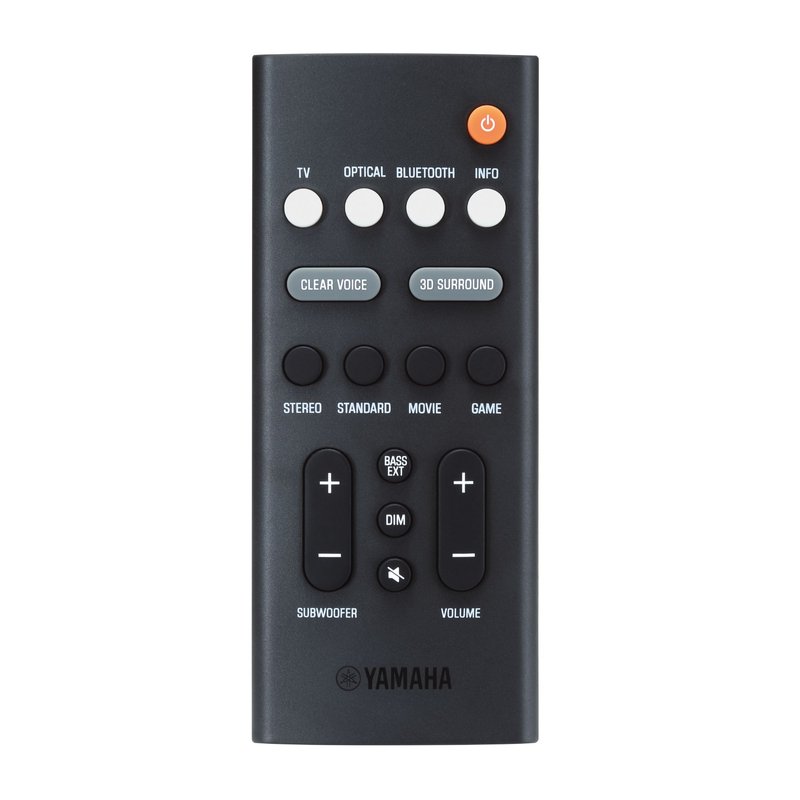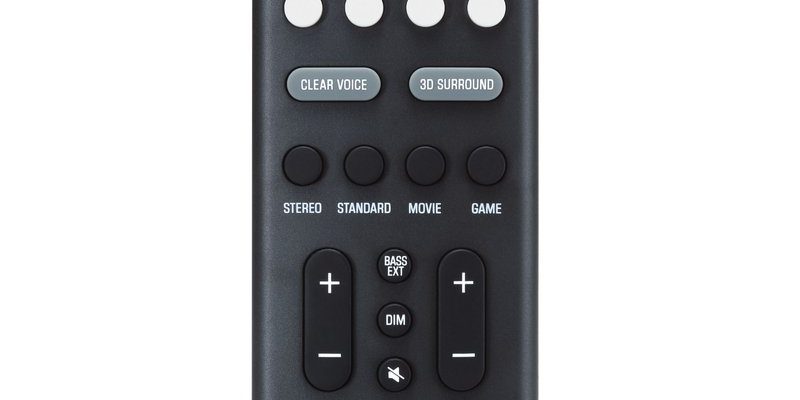
Let’s be honest: remotes seem to multiply overnight. Yamaha’s soundbars typically come with their own remote, and at first glance, it’s easy to wonder if it could double up and boss around the other gadgets living under your TV. Not to geek out, but the tech behind remotes—IR codes, syncing, pairing, and all that—can get a little wild. But don’t worry, you don’t need a degree in electrical engineering to follow along. I’ll break it down as if we’re figuring this out together, probably while both of us are sitting cross-legged on the living room floor with a bag of chips.
How Yamaha Soundbar Remotes Usually Work
When you unwrap a brand-new Yamaha soundbar and see the remote, it’s easy to assume it’s got superpowers. Sadly, most Yamaha soundbar remotes are pretty focused—they’re built specifically to control your soundbar and, at times, very basic TV functions like volume or mute. They use either infrared (IR) signals or in some cases, Bluetooth, to communicate. Think of it like a walkie-talkie tuned to a single channel—your Yamaha soundbar.
Now, there are some soundbars equipped with a “learning” feature. This lets the remote pick up simple commands from your TV’s remote, like volume adjustments. But here’s the thing: that’s about as far as it usually goes. Their “vocabulary” is limited; they’re not designed to memorize dozens of codes and commands from various streaming devices.
I remember the first time I tried to get my Yamaha remote to pause my Apple TV. Spoiler: it just stared at me blankly (figuratively, but you get the idea). Most Yamaha remotes simply aren’t universal—unless the model is explicitly described as such, it won’t natively control external streaming boxes.
What About Universal Compatibility and Learning Modes?
Let me explain a bit about “learning” and universal remotes so you don’t get lost in tech jargon. Some fancy Yamaha models have a learning mode, which means you can “teach” the remote very basic commands from another remote—usually just power and volume. Here’s where it gets tricky. Most streaming devices use their own set of codes and communication styles, and many newer ones (like Fire Stick or Apple TV) use wireless Bluetooth or Wi-Fi, not infrared.
So even if you’re ready to play teacher and student with your Yamaha soundbar remote and your streaming remote, it’s generally a no-go for streaming-specific functions like play, pause, or browse. At best, you might get some luck with turning the TV on or off, or controlling volume, but scrolling Netflix? Nope.
If controlling everything with one remote sounds appealing, you may want to try a true universal remote instead. These are made to pair (and re-pair, and reset) with tons of devices using massive libraries of control codes, or even online updates to match the latest gadgets.
Why Most Streaming Devices Don’t Play Nice With Soundbar Remotes
You might be wondering why your Yamaha soundbar remote can’t just magically talk to your Roku or Fire Stick. Here’s the thing: most modern streaming devices use wireless signals (Bluetooth, Wi-Fi) for their remotes, while Yamaha soundbar remotes stick to the old-school infrared.
Imagine trying to have a conversation where one person is whispering in French and the other is shouting in Italian—nothing gets through. The technology just doesn’t operate on the same wavelength, literally and physically. Even if you try to “pair” or “sync” the Yamaha remote, the streaming box isn’t listening to IR signals, unless it has an IR receiver built-in (which most don’t anymore).
Some TVs, though, have a neat trick called HDMI-CEC (Consumer Electronics Control). If everything’s hooked up just right, your TV remote might boss around the soundbar and streaming stick through the HDMI cable. But again, Yamaha’s own remote usually stays in its own lane.
Common Problems When Trying to Sync or Pair Yamaha Remotes
Let’s talk about headaches you might already have. Maybe you tried to code your Yamaha remote with the streaming box, only to get… crickets. Or you mashed buttons, hoping one would miraculously activate your Fire Stick, and nothing happened. Here are the real hurdles:
- Wrong Communication Type: If your streaming stick only “listens” for Bluetooth or Wi-Fi, your Yamaha’s IR remote is basically invisible.
- No Universal Remote Function: Most Yamaha soundbar remotes aren’t designed for cross-device control. Their chipsets just don’t have the right code library loaded.
- Pairing Process Fails: Even if you try a “reset” or “sync” process, the streaming device ignores IR signals, so the attempt goes nowhere.
- Battery Issues: Weak or old batteries can make IR signals unreliable or weak—but even with fresh batteries, it won’t solve the communication mismatch.
Honestly, if you keep running into a wall, it isn’t you. The devices just aren’t set up to play together easily, unless you bridge with a universal remote, or use HDMI-CEC features on your TV.
Alternatives for All-in-One Remote Control
So if your dream is to control everything from one place, you’re not out of luck—just don’t expect your Yamaha soundbar remote to pull it off. Here’s what actually works in the real world:
- Universal Remotes: These are specifically made to pair with all your living room gadgets. They use massive code lists and can usually control soundbars, TVs, and streaming devices, if set up right. Think Logitech Harmony remotes (if you can find one used these days).
- HDMI-CEC on Your TV: Some TVs let you control everything connected via HDMI with **one** remote. Your TV passes commands to your soundbar and streaming stick. But the remote doing the control is the TV’s, not Yamaha’s.
- Voice Assistants: If you’ve got an Alexa, Google Assistant, or Siri-compatible device, you might be able to control streaming and volume hands-free. Again, Yamaha remotes aren’t the stars here.
- Mobile Apps: Some soundbars and streaming devices have companion apps that turn your phone into a super-remote. It’s not quite as “tactile,” but no more battery-swapping and it’s hard to lose your phone under the couch… right?
Troubleshooting: If Your Yamaha Remote Isn’t Working At All
Let’s say your Yamaha soundbar remote isn’t just ignoring your streaming device—it’s ignoring everything. Time for a little troubleshooting:
- Battery Check: Seriously, double-check the batteries. I’ve been embarrassed by dead batteries more times than I’d like to admit.
- Reset the Remote: Unplug the soundbar, take batteries out of the remote, wait a minute, plug back in, and try again. Sometimes a total “reset” works wonders.
- Code Re-Sync: If your soundbar has a “learning” mode, re-sync it with your TV remote for basic volume and power commands.
- Remove Obstacles: Make sure nothing is blocking the little IR window on your soundbar—it needs a clear line of sight.
- Check the Manual: There are sometimes sneaky little steps unique to your model. Yamaha’s support website can be weirdly helpful.
If none of this helps, you might be dealing with a faulty remote. Replacement Yamaha remotes aren’t hard to find online, but don’t expect them to control your streaming stick any better than the first one.
Comparing Brand-Specific Remotes vs Universal Remotes
Here’s where I’ll get a bit opinionated: brand-specific remotes like Yamaha’s are laser-focused. They do their job—controlling your soundbar and maybe your TV volume—but that’s about it. They’re “specialists,” not “generalists.” Universal remotes, on the other hand, are like Swiss Army knives. With the right code and a bit of setup, they can juggle just about anything in your entertainment setup.
But, there’s a trade-off: universal remotes take time to set up and sometimes need “code” updates. You might have to look up manuals, enter pairing codes, or even download update files. It’s a small price to pay for fewer remotes, though.
Pro tip: If you’re sick of clicking around, universal remotes with learning modes and online code libraries are your best bet for full living room harmony.
So, Can Yamaha Soundbar Remotes Control Streaming Devices?
Here’s the bottom line: Yamaha soundbar remotes are not designed to control streaming devices like Roku, Fire Stick, or Apple TV. They’ll control your soundbar perfectly, and might even adjust your TV volume or power if you use the “learning” feature. But because streaming remotes often need Bluetooth or Wi-Fi and use unique control codes, Yamaha remotes can’t pair, code, or sync with them.
If all-in-one control is what you’re after, invest in a dedicated universal remote, check if your TV supports HDMI-CEC, or try using mobile apps. Don’t waste precious movie time trying to force your Yamaha remote to do magic tricks it just isn’t cut out for.
Honestly, wrestling with remote controls is a rite of passage in the home theater world. Once you find the right setup—be it a universal remote, your voice, or a trusty app—you’ll finally get to lean back, snack in hand, and enjoy your shows without remote-induced stress. Isn’t that what entertainment nights are supposed to be about?
